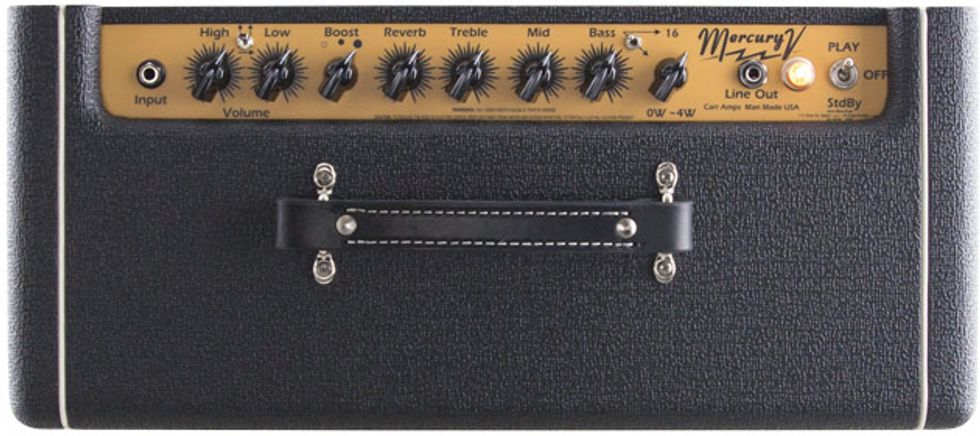All amps from North Carolina-based builder Steve Carr are steeped in vintage designs, but he isn’t afraid to wander from the retro path. He mixes and matches features, violates norms, and routinely makes classic circuits sound better than ever.
Mid-Atlantic Accent
The Mercury V is a perfect example of this “tradition with a twist” approach. Carr describes the 16-watt 1x12 combo as the “British cousin” of his Fender-flavored Skylark combo. (Carr’s previous Mercury models were only 8 watts.) The Brit-style features include a simple yet absurdly versatile preamp section that mimics the gain characteristics of Marshall amps from the ’60s though the ’90s. The Celestion speaker is another British nod.
But there are at least as many features from west of the Atlantic. The power tubes aren’t the big bottles used in large Marshalls, or even the EL-84s that power 18-watt Marshall combos and Vox AC15s, but a pair of 6V6s, the standard for medium-small Fender amps such as Princetons. Another non-vintage-Marshall feature is a gorgeous-sounding MOD spring reverb.
The gorgeous doesn’t end there. Mercury V’s cabinet is dovetail-jointed pine clad in jet-black tolex with white piping and an artfully oblique baffle board cut. (Carr will custom-build cabinets in different colors.) The cab’s design angles the speaker slightly upward, increasing the likelihood that you’ll serenade your ears, not your ankles.
Like all Carr amps, Mercury V is point-to-point hand-wired without turret board (though there’s a small board for one sub-circuit). A peek inside the stout metal chassis reveals—well, frankly, it looks like something out of Dante’s “Inferno,” with components branching off wildly from pots and tube sockets, often secured by glue-gun globs. But closer inspection (and careful chopstick poking) confirms that everything is solid. The top-shelf components include audiophile cable, Solen and Jupiter caps, carbon-comp resistors, and Carr’s custom-spec transformers. The rectifier is solid-state.

The Core Values
The Mercury V displays classic 6V6 response: warmly rounded tones, super-smooth transition to overdrive at relatively modest levels, and magnificent dynamic response. You can set the amp loud and go from clean to dirty via your guitar’s volume pot. Or just dial in a moderate-gain setting and regulate the distortion by touch. The light, resonant cabinet with its upward tilt distributes sound beautifully. The 65-watt Celestion Creamback G12M-65 sounds glorious, delivering crisp, articulate highs without compromising the amp’s innate warmth. It moves plenty of lows, too. The amp is probably loud enough for small club gigs un-miked, unless your bandmates are real loud.
There’s also a terrific-sounding attenuator. A toggle switches the amp from 16-watts to 4-watts, with a knob that can lower the power to nearly 0 watts. Whisper-level settings can sound astonishingly good, humming with true power-tube distortion. And when life demands absolute silence, you can record via the 1/4" output jack.
The 3-band tone stack has a Fender/Marshall feel, but with a slightly extended range. There’s a bit more treble and bass on tap, and the midrange control is powerful enough to overdrive some otherwise clean settings when maxed out. But for many players, these will be set-and-forget controls, with most tone shaping handled at the input/preamp stage. Speaking of which…
Ratings
Pros:
Superb tones. Superb workmanship. Superb range. Superb everything else.
Cons:
Pricey, thanks to premium materials and a labor-intensive build.
Tones:
Ease of Use:
Build/Design:
Value:
Street:
$2,530
Carr Mercury V
carramps.com
Might as Well Jumper
Early Marshall amps had two input channels and four input jacks. (That’s right, kids. After your grandparents walked 10 miles home from school on frostbitten bare feet, they sometimes had to play in bands with two or more musicians sharing the same amp.) Guitarists soon realized they could re-purpose the multiple jacks and jumper the channels, playing through both in parallel. This provided more distortion and a secondary set of tone controls (based on the relative levels of the bright and normal channels). A few years later, when guitar tones got chunkier, some wily techs would mod the amps so the channels were in series. This practice paved the way for the ultra-high-gain amps of the ’80s and ’90s, which employed multiple preamp stages in series.
Mercury V is all of the above. By default, the input feeds both channels in parallel. (Each channel has a volume knob, so you can get a one-channel sound by zeroing either control.) Depending on the blend, you can get everything from a dark-toned rumble to a strident squawk.
An additional toggle arranges the two channels in series for distortion ranging from crunchy to apocalyptic. And then there’s another layer of control: a 3-way boost switch. At its lowest setting, the amp’s gain is equivalent to, say, a blackface Fender or a mid-’60s Marshall. The middle setting is more aggressive, suggesting a metal-plate Marshall or a hot-rodded Fender combo. The third setting is really frickin’ gainy. But these are generalizations, since the response can vary so much according to the input/preamp settings. Executive summary: Killer tones at all gain levels.
The Verdict
From crystalline blackface sounds to high-gain obesity, Mercury V’s tones ring from the speaker with both warmth and presence. The preamp section has remarkable range, accessible via a few simple controls. Notes and chords sustain sweetly, especially when you push the output section (which is easy to do, thanks to the built-in attenuator). The amp looks beautiful. Workmanship is top-notch. And while the price is formidable, it’s understandable given the amp’s extremely labor-intensive build. Mercury V is simply one of the finest-sounding amps I’ve ever played.
Watch the Review Demo:









![Rig Rundown: Russian Circles’ Mike Sullivan [2025]](https://www.premierguitar.com/media-library/youtube.jpg?id=62303631&width=1245&height=700&quality=70&coordinates=0%2C0%2C0%2C0)

















